We live at the bottom of an ocean of air. Each of us is carrying around 14.7 pounds per square inch when at the beach in Miami1. We are powerful creatures indeed. Imagine carrying around 101,000 Pascal’s on that beach. Or 1,010 millibars. As elevation increases the weight of the air we are carrying around decreases. This decrease in weight with elevation is called the lapse rate (Figure 1).
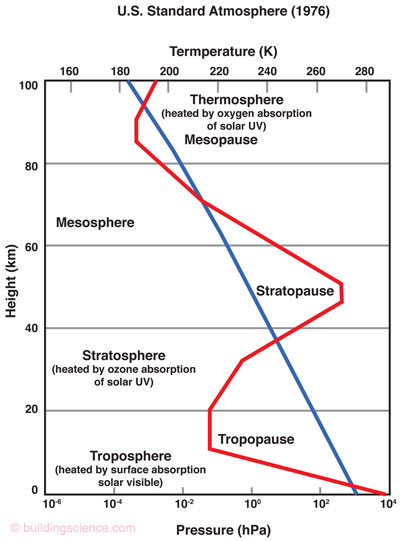
Figure 1: Lapse Rate—This is a chart of the U.S. Standard Atmosphere. The “red” line is the temperature lapse rate. The “blue” line is the pressure lapse rate. The pressure lapse rate is around 12 Pa per meter or 3.6 Pa per foot.
The lapse rate thing gets interesting with buildings. In a heated building the lapse rate inside is less than the lapse rate outside. This is due to the reduced density of heated air compared to unheated air. Check out Figure 2. The assumptions in this figure are important. There is only one hole in the building enclosure and it is at the bottom. There are also no interior floors or partitions. So we have an airtight building (except for the one hole at the bottom) with no interior flow resistance. And the building is heated. At the hole the pressure inside equalizes with the pressure outside. As we go up with height the pressure difference between the inside and outside gets bigger. This difference in pressure is called the stack effect.
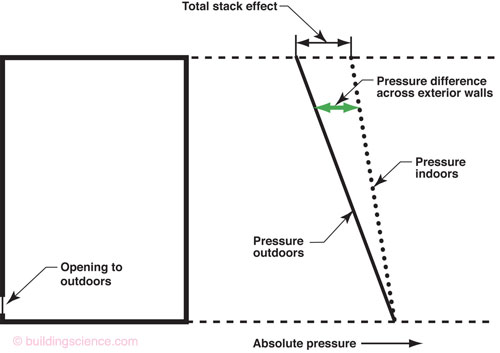
Figure 2: Stack Effect - Building with no internal separations with opening at the bottom
(adapted from Handegord, 1998).
The stack effect gets its name from the same phenomenon that causes hot combustion gases to rise in a chimney or chimney stack. A heated house or heated building can be considered a giant chimney that we live and work inside of. The taller the building the greater the stack effect. The colder the temperature the greater the stack effect. So, in heated buildings, the air tends to flow out of the top of the building while inducing air to flow in at the bottom.
Now lets look at Figure 3. The hole is at the top of the building. All other assumptions are the same. Once again, at the hole, the pressure inside equalizes with the pressure outside. As we go down in height the pressure difference between the inside and outside gets bigger—but it is in the opposite direction. Neat, eh? The interior pressure line (the interior lapse rate “line”) moves laterally- horizontally - shifts to the left from Figure 2 to Figure 3. The “solid” line does not move. The “dotted” line moves. The slope of the “dotted” line does not change, it just shifts left.
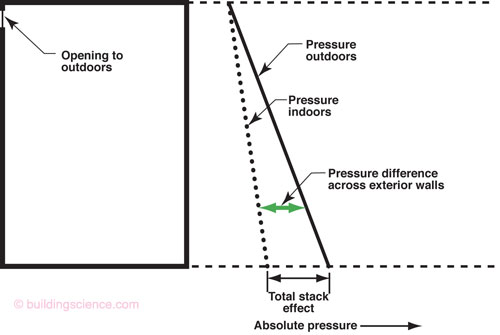
Figure 3: More Stack Effect - Building with no internal separations with opening at the top
(adapted from Handegord, 1998).
What happens when we have two holes the same size? One at the top and one at the bottom? Check out Figure 4. The “dotted” line shifts right partially. It crosses the “solid” line smack dab in the center of the building elevation wise. Where the interior lapse rate line crosses the exterior lapse rate line the pressure inside equals the pressure outside. No pressure difference exists. We call that the neutral pressure plane or neutral pressure zone. A real smart old guy wrote about this in this Journal in 1926.2
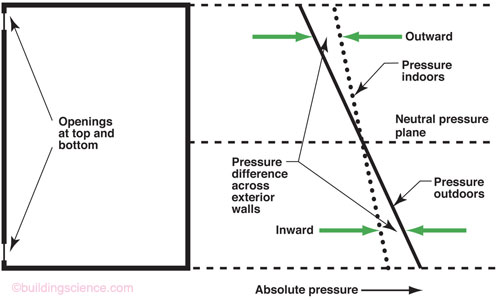
Figure 4: And Still More Stack Effect - Building with no internal separations with openings at the top and bottom (adapted from Handegord, 1998). Beginning to look familiar, eh? Notice the “neutral pressure plane”. At the neutral pressure plane no difference in pressure exists between the inside and the outside.
Now lets modify the assumptions a bit. Lets assume a uniform distribution of leakage areas. All surfaces are uniformly leaky—same size holes—same distribution. Also, and this is the tricky assumption, lets assume “no flow”3. Now let’s put a vented attic on top of the box. We get Figure 5. All holes above the neutral pressure plane would have air “exfiltrating” if there was flow. All holes below the neutral pressure plane would have air “infiltrating” if there was “flow”.
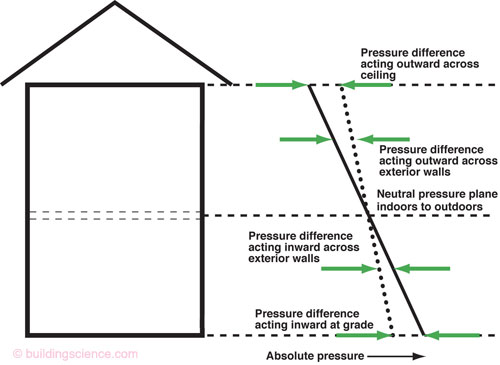
Figure 5: House - Basic two story house with vented attic (adapted from Handegord). The assumption here is a uniform distribution of leakage areas. All surfaces are uniformly leaky. All holes above the neutral pressure plane have air “exfiltrating”. All holes below the neutral pressure plane have air “infiltrating”.
How does the neutral pressure plane know where it is supposed to be? Ah, Grasshopper, it always knows. In the absence of wind and exhaust fans, supply fans and ducted HVAC systems and interior partitions…..weasel words for sure…roughly half the holes are above the neutral pressure plane and roughly half the holes are below the neutral pressure plane. We are talking surface area wise…sort of. There are cracks and there are straight through to the outside holes and there are tortuous paths…It gets worse. Holes farther away from the neutral pressure plane are more “important” than holes closer to the neutral pressure plane. It is sort of like a “moment” calculation in structural engineering. The “effective area” of a hole is multiplied by its distance to the neutral pressure plane and this product is added to the next product of the “effective area” of a hole multiplied by its distance to the neutral pressure plane for all of the holes above the neutral pressure plane. Yes, you all know where this is going…this sum must equal the sum of the same exercise of all of the holes below the neutral pressure plane.
Bottom line: sealing big holes in the attic moves the neutral pressure plane down and sealing big holes in the basement moves the neutral pressure plane up. This has very interesting consequences. Let’s say you want to keep radon gas out of your basement4. Sealing big holes in you attic helps as it lowers the neutral pressure plane and reduces the pressures across the holes at the bottom of your building.
Let’s say you were running an energy conservation program in a country where it is cold and they play hockey outside and you wanted to insulate attics. But when you first just added a bunch of attic insulation you rotted out a whole bunch of attics because you made the attics colder and negated the effect of attic ventilation on controlling attic moisture problems because attic ventilation needs heat loss to work. So you wanted to fix this and you did fix this by sealing the big holes in the ceiling - the “attic bypasses”—to prevent interior moisture laden air from getting into the attic and causing those nasty attic moisture problems. You fixed it by mandating air sealing your attic ceiling as part of your insulation strategy. Guess what happened to the location of the neutral pressure plane? Yup. You lowered it and exposed more of your exterior walls to exfiltration. You just moved the attic moisture problem to your walls. Bummer. It got worse.
Most homes in cold climates were heated with fuel burning furnaces - gas and oil heat. These appliances had chimneys. As far as building enclosures are concerned chimneys are exhaust fans—big ones at that. Exhaust fans and chimneys tend to raise the neutral pressure plane. Most houses in cold climates with big oil and gas furnaces had neutral pressure planes located above attic ceilings (Figure 6). This had enormous implications for building durability.
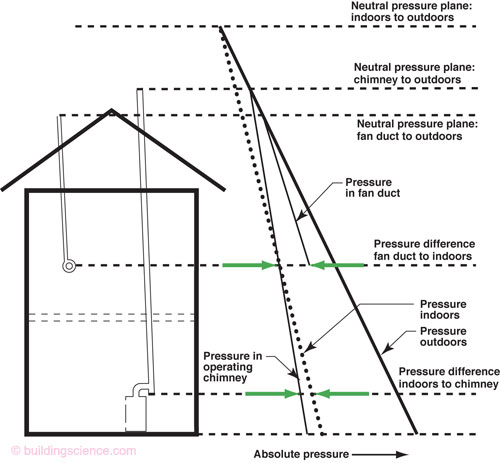
Figure 6: House With Operating Chimney—The operating chimney depressurizes the house by raising the neutral pressure plane well above the ceiling (adapted from Handegord). It was hard to rot a house in a cold climate that had a neutral pressure plane located above the ceiling. It was hard, but not impossible, you could do it with rain leakage.
With neutral pressure planes located above ceiling lines the entire building enclosure sees infiltration. Infiltrating air does not bring moisture with it in a cold climate during the heating season. Exfiltration hurts you, not infiltration, in a cold climate. And exfiltration hurts you only if the exfiltrating air has lots of moisture in it. It was hard to rot a house in a cold climate that had a neutral pressure plane located above the ceiling5. The old big chimneys did two things—they raised the neutral pressure plane above ceilings and they also provided a large air change that served to dilute interior moisture levels.
Of course the “bad thing” about these old oil and gas furnaces with big chimneys was that they were very energy inefficient. We began to replace them with sealed combustion appliances. We also discovered heat pumps and electric heating. No chimneys. Neutral pressure planes dropped like rocks and dilution air change that came from operating chimneys disappeared. So interior moisture levels went up precisely at the same time large portions of building enclosures became exposed to exfiltrating air.
Getting rid of active chimneys and air sealing attic ceilings dropped neutral pressure planes and caused moisture havoc in cold climate exterior walls (Photograph 1 and Photograph 2). Just by looking at buildings you could often tell where the neutral pressure plane was. Many two story houses had frost on the second floor windows whereas the first floor windows were clear—infiltration through the lower windows and exfiltration through the upper windows—neutral pressure plane between the two.
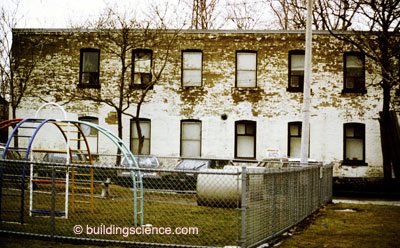
Photograph 1: Peeling Paint “Tell” - Where is the neutral pressure plane in this photograph? Neat eh? Air exfiltrating above the neutral pressure plane typically carries interior moisture. This moisture is deposited in the wall leading to peeling paint problems. Below the neutral pressure plane air is infiltrating from the exterior carrying little or no moisture. Legend has it that in this building an old oil boiler with a large active chimney was replaced with a sealed combustion condensing gas boiler lowering the neutral pressure plane. Of course, this picture could also be explained by rain deposition, but I am sticking with the air leakage neutral pressure plane story because it is so cool.
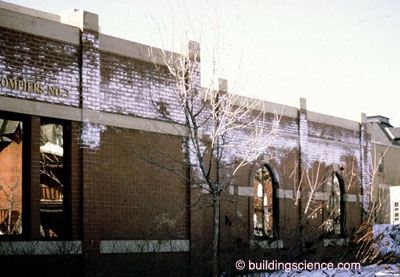
Photograph 2: Stack Effect Damage—This is stack effect air leakage leading to moisture induced damage for sure. Not rain. Why? Only happens in winter when it does not rain. Efflorescence. It came from inside and ate your building…. wooo…scary stuff boys and girls…
When we go to high-rise buildings the principles remain the same as do the problems. Stack effect driven airflows in tall buildings compromise smoke control and fire safety, adversely affect indoor air quality and comfort as well as increase operating costs for space conditioning energy (Figure 7). The air in lower units ends up in the upper units. I guess that is why folks in the upper units pay more for the privilege.
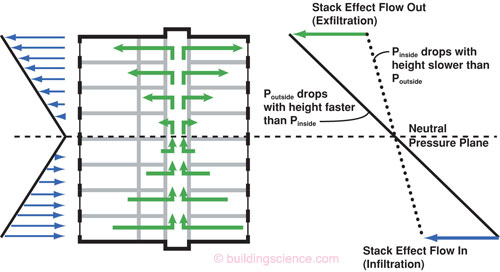
Figure 7: Stack Effect in a Tall Building—Stack effect driven airflows in tall buildings compromise smoke control and fire safety, adversely affect indoor air quality and comfort as well as increase operating costs for space conditioning energy. The air in lower units ends up in the upper units. I guess that is why folks in the upper units pay more for the privilege.
By isolating the units from each other and from corridors, shafts, elevators and stairwells stack effect driven interior airflows can be controlled (Figure 8). Today we call this compartmentalization. The most elegant argument for compartmentalization of tall buildings came from Handegord (2001).

Figure 8: Compartmentalization— Basically, you turn a ten story building into ten one story buildings that are stacked on top of one another. By isolating the units from each other and from corridors, shafts, elevators and stairwells stack effect driven interior airflows can be controlled.
Basically, you turn a ten story building into ten one story buildings that are stacked on top of one another. We wrote about this much earlier in BSD-110: HVAC in Multifamily Buildings.6
Achieving compartmentalization is not easy. You have to think 3 dimensionally and treat your interior walls like exterior walls (Figure 9). Back in the day some of us guessed at what unit air tightness should be. I proposed a minimum resistance or air permeance of 2.00 L/(s•m2) @ 75 Pa (Lstiburek, 2005). It seems to be working. This level of unit air tightness is necessary to control stack effect air pressures and to limit airflow from adjacent units and cross contamination.
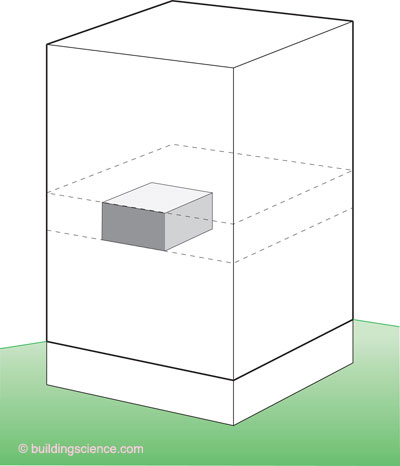
Figure 9: More Compartmentalization—You have to think 3 dimensionally and treat your interior walls like exterior walls. A minimum resistance or air permeance of 2.00 L/(s.m2) @ 75 Pa of unit air tightness is necessary to control stack effect air pressures and to limit airflow from adjacent units and cross contamination.
Let’s say you achieve compartmentalization. You are not done. Now the mechanical engineer can screw it all up by running ducts and shafts vertically. No central systems. You can’t make that work. You need to keep the ducts within each compartment and vent directly to the exterior (Figure 10). No complaints from you architects about penetrations being ugly. Just deal with it.
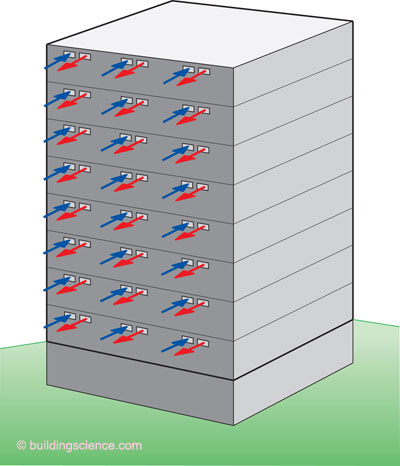
Figure 10: Unit Ventilation—Do not run ducts and shafts vertically. No central systems. You can’t make that work. You need to keep the ducts within each compartment and vent directly to the exterior. No complaints from you architects about penetrations being ugly. Just deal with it.
The compartmentalization principle can also be extended to heating, cooling and domestic hot water. Unit space heating and cooling and hot water is provided by individual mechanical systems located in each unit (Figure 11).
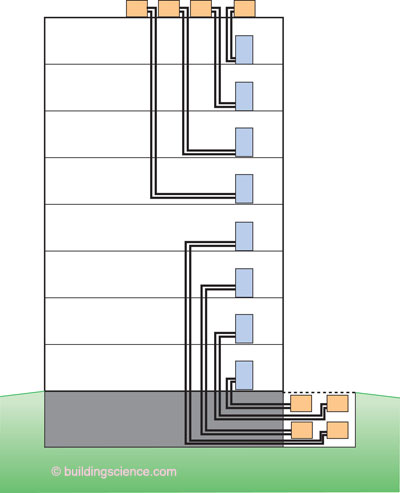
Figure 11: Space Conditioning and Hot Water—The compartmentalization principle can also be extended to heating, cooling and domestic hot water. Unit space heating and cooling and hot water is provided by individual mechanical systems located in each unit.
Rooftop penetrations are collected and located in “doghouses” minimizing penetrations. All cable, duct and pipes are run through walls of “doghouses” (Photograph 3). The “doghouse” lids are removable allowing for access.
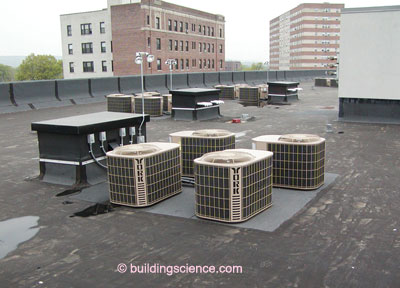
Photograph 3: Distributed Mechanical Systems—This is why the Gods of Building Science invented flat roofs: a place to stash mechanicals. Rooftop penetrations are collected and located in “doghouses”—all cable, duct and pipes are run through walls of “doghouses”.
So at the end of the day how do things stack up for us? In houses we have learned to live with lower neutral pressure planes by designing and constructing walls to be more moisture tolerant and we have learned to compensate for the lack of active chimney induced air change by providing controlled ventilation systems. In tall buildings we are learning to compartmentalize and to provide distributed ventilation, distributed space conditioning and distributed hot water. Carrying around the weight of that ocean of air doesn’t seem so difficult any more.
References
Emswiler, J.E.; The Neutral Zone in Ventilation, ASHVE Journal, Vol. 32, 1926.
Handegord, G.O. “Building Science and the Building Envelope”, Handegord and Company, 1998.
Handegord, G.O. “A New Approach to Ventilation of High Rise Apartments” Proceedings of the Eighth Conference on Building Science and Technology, Ontario Building Envelope Council, Toronto, Ontario, February, 2001.
Lstiburek, J.W. “The Pressure Response of Buildings” Thermal VII, ASHRAE/DOE/BTECC, December 1998
Lstiburek, J.W. “Understanding Air Barriers” ASHRAE Journal, July 2005.
Lstiburek, J.W. “Multifamily Buildings” ASHRAE Journal, December 2005.
Footnotes
- Why Miami? Ah, I am thinking warm thoughts. Any sea level location would have worked. Unfortunately the International Civil Aviation Organization (ICAO) Standard Atmosphere assumes a temperature of 15 degrees C (59 degrees F). Not exactly bathing suit weather except for Canadians. It also assumes no water vapor. So it is a “dry cold”…
- No, I never met Professor Emswiler. Not even I am that old. Check out the reference at the end of this column. University of Michigan lad. Go Wolverines. Professor Emswiler also wrote a classic text on thermodynamics amazingly enough called “Thermodynamics”.
- Don’t bust my chops on this ok—actual flow will result in modified pressures—there is friction and a bunch of other stuff to consider—these types of diagrams represent the maximum theoretical pressures. If you want to go into the weeds get the original paper or even better read Handegord—see reference at end of this column. ASHRAE Fundamentals is good too. Or go take Collin Olson of the Energy Conservatory to lunch.
- For many years I have thought that the EPA placed a misguided emphasis on radon mitigation—but I kept silent—ok, not always—because it had a fabulous collateral outcome of handling soil gas and pesticide and ground contamination issues which in my opinion where much more significant to deal with. If you can measure stuff you can scare the peasants. Radon was easy to measure and the radiation thing was so Sci Fi and easy to relate to every pseudo disease.
- It was hard, but not impossible, you could do it with rain leakage.
- Make no mistake about this—I was channeling Gus—this is not my stuff—I just grabbed onto it earlier than most. Gus was on to this very early, he just didn’t always write things down and get them published and peer reviewed in a timely fashion. He finally wrote it all down in his 2001 paper but I first heard it from him when I took his class at the University of Toronto in 1982 and he was talking about it much earlier than that. I was pushing compartmentalization when I first started working in the United States in 1986. I still smile when I remember the arguments with the Chicago high-rise boys in the late 80’s.
